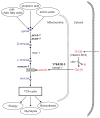Worms, bacteria, and micronutrients: an elegant model of our diet
- PMID: 25172020
- PMCID: PMC4399232
- DOI: 10.1016/j.tig.2014.07.010
Worms, bacteria, and micronutrients: an elegant model of our diet
Abstract
Micronutrients are required in small proportions in a diet to carry out key metabolic roles for biomass and energy production. Humans receive micronutrients either directly from their diet or from gut microbiota that metabolize other nutrients. The nematode Caenorhabditis elegans and its bacterial diet provide a relatively simple and genetically tractable model to study both direct and microbe-mediated effects of micronutrients. Recently, this model has been used to gain insight into the relationship between micronutrients, physiology, and metabolism. In particular, two B-type vitamins, vitamin B12 and folate, have been studied in detail. Here we review how C. elegans and its bacterial diet provide a powerful interspecies systems biology model that facilitates the precise delineation of micronutrient effects and the mechanisms involved.
Keywords: Caenorhabditis elegans; folate; gut microbiota; metabolism; micronutrients; vitamin B.
Copyright © 2014 Elsevier Ltd. All rights reserved.
Figures



References
-
- Sommer F, Backhed F. The gut microbiota - masters of host development and physiology. Nat Rev Microbiol. 2013;11:227–238. - PubMed
-
- Tremaroli V, Backhed F. Functional interactions between the gut microbiota and host metabolism. Nature. 2012;489:242–249. - PubMed
-
- LeBlanc JG, et al. Bacteria as vitamin suppliers to their host: a gut microbiota perspective. Current opinion in biotechnology. 2013;24:160–168. - PubMed
-
- Tilg H, Moschen AR. Microbiota and diabetes: an evolving relationship. Gut 2014 - PubMed
Publication types
MeSH terms
Substances
Grants and funding
LinkOut - more resources
Full Text Sources
Other Literature Sources

